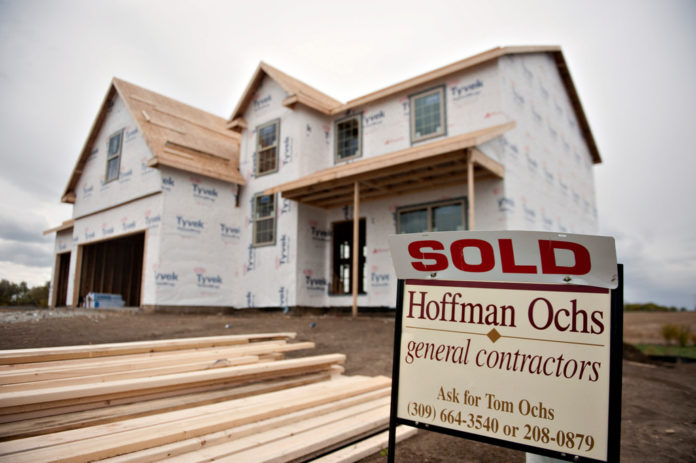
WASHINGTON — Sales of new U.S. homes rose more than forecast in June to the highest level in five years, a sign builders are benefiting from a lack of supply of existing properties.
Purchases climbed 8.3 percent to an annualized pace of 497,000 homes, highest level since May 2008, the Commerce Department said today in Washington. The median estimate of 77 economists surveyed by Bloomberg called for a gain to 484,000.
The gains will keep propelling residential construction and home values, giving the world’s largest economy a boost. Growing employment and the desire to take advantage of historically low borrowing costs before they rise further will probably release pent-up demand from consumers who had held off during the recession and early stages of the expansion.
“It’s a builder’s market,” said Stuart Hoffman, chief economist at PNC Financial Services Group in Pittsburgh, who forecast a gain to 500,000. “The housing market is poised for further gains and is a key component of the U.S. recovery overall.”
Stocks dropped, erasing earlier gains, as investors weighed Apple Inc. profit that topped estimates with a worse-than- estimated forecast from Caterpillar Inc. The Standard & Poor’s 500 Index declined 0.1 percent to 1,689.98 at 10:20 a.m. in New York.
Projections in the Bloomberg survey ranged from 415,000 to 518,000. The Commerce Department revised the May figure to 459,000 from a previously reported 476,000.
Sales jumped 38.1 percent from June 2012, the biggest year- over-year gain since January 1992.
Prices climb
The median selling price of a new home appreciated 7.4 percent to $249,700 last month from $232,600 in June 2012.
Purchases rose in three of four U.S. regions, led by an 18.5 percent surge in the Northeast. They climbed 13.8 percent in the West and 10.9 percent in the South. Demand dropped 11.8 percent in the Midwest.
The supply of homes at the current sales rate was 3.9 months, matching January’s level as the lowest since 2004 and down from 4.2 months in May. There were 161,000 new houses on the market at the end of June, up from 159,000 a month earlier.
Sales of new properties, which are tallied when purchase contracts are signed, are considered a more timely measure of the market than sales of previously owned dwellings, which are counted when a sale is final. New-home sales accounted for about 7 percent of the residential market in 2012.
‘Sold out’
Gretchen Apps, a broker for Weichert Realtors in Chadds Ford, Pennsylvania, said demand for new homes is out-pacing land supply. Since January, she and her co-worker have sold all of the new homes she had listed — one model home and five under- construction or soon-to-be-built in West Chester, Penn.
“It’s been really moving: we even sold where we really didn’t have anything to show,” Apps said. The houses, all priced at more than $600,000, look traditional even though they have modern amenities inside, she said. “We’re sold out. We are just sad we don’t have more land.”
An improving job outlook may be creating confidence and encouraging buyers. Employers in the U.S. added 195,000 jobs in June for the second straight month.
Improvements in the employment situation and the housing market could boost business at companies such as Whirlpool Corp. The outlook for North America is improving, the appliance makers’ CEO Jeff Fettig said in a July 19 earnings call.
Broad-based gains
“We’re increasing our industry demand assumption to be up 6 percent to 8 percent for the year,” Fettig said. “We continue to see very positive trends in U.S. housing as well as pickup in really all segments of the market.”
Homebuilders have also grown more confident. The National Association of Home Builders/Wells Fargo index of builder sentiment climbed to this month to a seven-year high, the Washington-based group reported last week. The gauge has climbed 13 points in the latest two months, the biggest back-to-back advance since January-February 1992.
While higher borrowing costs spur demand in the short run as on-the-fence buyers take the leap to lock in rates, the current increase in interest rates represents a threat longer term. The average rate for a 30-year fixed mortgage was 4.37 percent last week, according to McLean, Virginia-based Freddie Mac. The rate reached a record low of 3.31 percent in November.
While rates are still historically low, that means the monthly payment on a $200,000 loan now would be $998 compared with $877 in November.
Supply constraints
Tight inventories also threaten to constrain progress. Purchases of existing homes unexpectedly fell 1.2 percent to a 5.08 million annualized rate in June, figures from the National Association of Realtors showed this week. The median forecast of 79 economists surveyed by Bloomberg called for a 5.26 million pace. Sales were the second-strongest since November 2009 following May’s downwardly revised 5.14 million rate.
Low supplies helped push the median price of an existing home up 13.5 percent to $214,200 last month from $188,800 a year earlier, the report showed.












